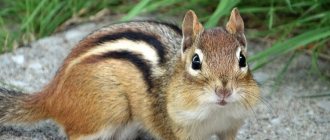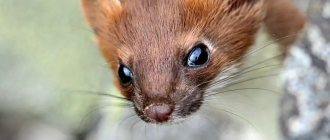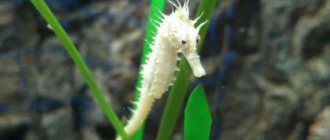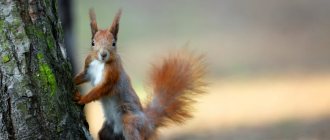Buying a rodent
So, having bought or made a piece of paradise for a chipmunk, we go shopping for it. This is quite a rare and exotic animal, so you may need to make a reservation at a pet store. You can also look for advertisements in the newspaper or on Avito, but still the best option is to search for the nearest nurseries or breeders, and there are very good reasons for this:
- Pet stores often bring animals caught in their natural habitat and smuggled in. This one will never become tame, and can bring with it many exotic diseases;
- Also, a chipmunk can live in a store for quite a long time, and its psyche may be disturbed (constant strangers, bad food, constant lighting and noise). This also does not make him more flexible.
When purchasing an animal from breeders, you are guaranteed to receive a breeding animal that is not afraid of people, and if necessary, you can always get advice by phone. When purchasing, the chipmunk must be a baby, it must fit freely in a child’s palm, but at the same time already be independent (6-8 weeks old), as in the photo below. The coat should be shiny, and in general the animal should look healthy.
Little chipmunk
The price for an animal starts from 5,000 rubles.
Note: by the behavior of an animal you can determine whether it is domestic or caught in captivity. It’s strange, but domestic chipmunks designate a certain corner of the cage for the toilet, where they take crushed sawdust or other filler, and only go there. Wild rodents go to the toilet anywhere.
Diet
Chipmunks, like all rodents, love nuts, cereals, and seeds in milky maturity. They will also not refuse to snack on insects, their larvae, and small quantities of vegetables and fruits. They can also attack small animals and birds, but for the most part they are vegetarians.
Chipmunk eats corn
Do not forget to change the water in the sippy cup with fresh water twice a day. The chipmunk is not prone to becoming overweight, as he is constantly in active motion, so you don’t have to be afraid of overfeeding. Fill the feeder in the morning, and during the day the animal will dispose of the gifts itself - it will eat something, and take something back to the house for supplies.
At home, you can also feed with tree buds, shoots, berries and mushrooms. Sometimes they even feed them with cottage cheese and plain milk, but this is optional.
It is also worth going to the nearest pet store and buying special food for squirrels and chipmunks. These foods contain enough solid food to grind down the constantly growing incisors.
Offspring of chipmunks
At home, chipmunks do not hibernate in winter - the temperatures are not right. But if you want to try to breed offspring, then hibernation is necessary. This requires three conditions:
- A pair of young mixed-sex chipmunks;
- Double cage connected by one closing passage;
- Low temperatures, close to zero degrees.
With the onset of autumn, when the animals stock up, you will notice their aggressive mood towards each other. This is a good sign; it is time to place them in their cages, close the passage, and provide a cold temperature. For example, move the cages onto a glazed but unheated balcony
Install a thermometer so that in severe frosts you do not overcool the animals; the temperature should not be lowered below zero. Chipmunks will hide in their holes and sleep until spring, no care required
For example, move the cages onto a glazed but unheated balcony. Install a thermometer so that in severe frosts you do not overcool the animals; the temperature should not be lowered below zero. Chipmunks will hide in their holes and sleep until spring; no care is required.
When the temperature rises to 10 degrees, they will wake up and the female will begin to whistle with a characteristic sound reminiscent of gurgling. This is the call of the male, it’s time to open the passage between the cells, to which the male will react very quickly.
Pregnancy lasts about a month, after which tiny chipmunks will appear, there can be up to 12 of them in a litter.
Newborn chipmunk
The female takes all the care; it is better to place the male again. In about a month, the babies will become independent, and by 6 weeks they can be sold
In the ad, indicate that you have parents of babies, this is very important for potential buyers, that the animals were bred at home
But it so happens that they rarely bear offspring; why this is so is unclear. They do not want to reproduce in captivity.
And remember - we are responsible for those we have tamed!
Read with this
What does it eat?
The basis of the chipmunks' diet is plant food, to which they occasionally add insects. In general, the composition of the feed is varied, including seeds of wild plants, buds of trees and shrubs, young branches, herbs, various berries, as well as acorns, pine and hazelnuts, and mushrooms. Near fields and vegetable gardens, chipmunks willingly feast on cereal grains, buckwheat, corn, flax, sunflowers, peas, cucumbers, plums, apricots and other crops grown by people.
For the winter, chipmunks also store a large variety of different foods: wheat, oats, buckwheat, flax, sunflowers, wild seeds, acorns, nuts, dried berries, apples, mushrooms. At the same time, the chipmunk never mixes different foods, but carefully puts them on a bed of dry grass in separate piles, or separates different foods using dry leaves. The amount of reserves in one burrow sometimes reaches 6 kg, since chipmunks are engaged in creating food reserves throughout the entire period before hibernation.
— Advertising —
The method of harvesting grain is interesting. The chipmunk climbs into a not very dense crop, selects a good ear, grabs a straw and jumps up. Because of its weight, the straw bends and the animal moves along it, holding it between its paws, and thus reaches the ear. Then he bites it off, selects the grain in a few minutes, hides it in his cheek pouches and leaves. In dense crops, where it is not possible to tilt the straw, the chipmunk bites it from below, biting off fragments and gradually reaching the ear.
Chipmunk price and place of sale
The chipmunk, like most of its relatives, should be purchased from rodent nurseries or pet stores. It is not recommended to make a purchase by hand, since it is quite possible to buy a not entirely healthy animal. The cost of such a pet may vary depending on the region of Russia. As for the center of the Russian Federation, the price of a chipmunk is about 5-6 thousand rubles.
A chipmunk at home will never cause problems with an unpleasant odor, since it is a very clean representative of rodents. With proper care and diet, such a pet will bring joy to all residents of the house, both children and adults, for many years.
Population and species status
Today, the Asian or Siberian chipmunk is listed in the Red Book of the Russian Federation and is protected by law. As for other species, there is very little data on them, although scientists know how the age composition of the population depends on the intensity of reproduction.
It is important to know! The size of the population and its age composition depend on the yield of the main components of the diet. In harvest years, by autumn, the animal population consists of almost 50 percent young animals, and in lean years this ratio decreases almost 10 times.
For example, in the western forests of the Sayan Mountains the maximum density of these animals is noted, up to 20 per 1 km. square, which is typical for tall grass pine forests. In the northeastern part of Altai, the highest number of chipmunks was recorded, up to 47 per 1 km. square, within the cedar-fir taiga. In other (mixed) types of forests there are much fewer of these animals. Their number ranges from 2 to 27, if we take purely adult livestock, and from 9 to 71 with the addition of young animals. The smallest number of chipmunks is typical for small small-leaved forests: only 1-3 per 1 square km by the beginning of summer and from 2 to 4 by the end of summer.
Pros of keeping chipmunks at home
- Unlike their closest relative, squirrels, they have virtually no unpleasant odor. In addition, they are very clean and tidy: they relieve themselves only in a certain place in the cage, do not scatter food, and often clean their fur.
- They quickly get used to taking food from human hands, which means they easily become tame. Getting used to the owners, the chipmunk will never bite them. Even small children react calmly to stroking. Only if they do not cause them pain and discomfort.
- They are interesting to watch. Over time, a chipmunk develops a clear daily routine. Waking up in the morning, after washing, he usually takes out all the bedding from the house for airing. During the day he does other things that are important to him: brushing his fur, checking his food supplies, playing. By evening he returns the bedding to its place. At night, tightly seal all the cracks and entrances in the house.
- Chipmunks are quite simple to keep and eat. To live, they need a cage with thick bars, bedding - preferably wood, and also a house: there he hides and sleeps. There should also be a feeder and water bowl in the cage. If the cage has a wheel and labyrinths where the animal can arrange “rooms,” then such a cage can be called ideal. The diet should be varied, but not too expensive: vegetables, fruits, grains, cereals, lettuce, nuts.
- Chipmunks are not cowardly animals. They are curious and brave, treat people without fear, do not hide from him in the house, ask him for food and sit calmly in his arms.
- Home weather station: Chipmunks can sense rain and announce its approach with funny sounds.
- Unlike the familiar rodents - hamsters and decorative rats, which live no more than 4-5 years, chipmunks can live in captivity for up to 10 years. Of course, provided that it is on the correct content.
Chipmunk appearance
These animals have fluffy skins. There are also characteristic longitudinal black stripes on the back and slightly on the sides. They alternate with gray and white stripes. The rest of the body is covered with brownish fur. In winter, the fur is thicker, and by summer the animals molt. Some individuals have light, almost white fur, but scientists do not classify them as albinos.
Chipmunks look a little like squirrels, but are much smaller and have completely different eye structures. Therefore, scientists have clearly differentiated these species. Male chipmunks are much larger than female chipmunks.
Chipmunks stuff food into their cheek pouches. These are quite curious animals. They monitor what is happening with their small eyes, similar to almonds. Chipmunks have small, round ears. The hind limbs are longer than the forelimbs.
What do chipmunks eat?
They especially love:
- all types of nuts;
- acorns;
- sunflower seeds;
- apple seeds;
- cereals;
- berries;
- fruits;
- carrot.
Veterinarians advise not to feed animals almonds, which contain hydrocyanic acid. It is very harmful to all rodents. You should not treat your pet to peanuts and sunflower seeds very often due to their high fat content.
Fruits should be peeled, since the animal is very sensitive to chemical additives. Large amounts of fruits and vegetables can cause diarrhea. You should constantly monitor your diet.
The chipmunk's favorite treats include:
- sugar;
- cookie;
- hard-cooked milk porridge;
- cottage cheese.
An important condition for a balanced diet for an animal is the availability of soft and dry food. Chewing hard food allows the rodent to constantly wear down its growing incisors. In addition to solid food, it is advisable to provide your pet with pieces of chalk. This way, he can grind down his teeth whenever he wants.
The chipmunk needs to constantly consume enough animal protein.
Therefore, on his table should be present:
- eggs;
- raw meat;
- insects (bugs, grasshoppers);
- mealworm larvae.
No matter how complete your pet’s feeding is, he will still make himself an “emergency supply.” This is how it is laid down at the genetic level. In the wild, one chipmunk can provide itself with eight kilograms of food for the winter. Therefore, do not forget to regularly inspect the animal’s house and throw away spoiled food.
It is very important to change the water in the drinking bowl every day. Give preference to a waterer that is used for birds
After all, the chipmunk is very active. He's always carrying something, he's in a hurry somewhere, and he definitely won't be able to knock over such a drinking bowl.
Follow all our recommendations, and your pet will be fed, healthy and cheerful!
Nutrition
Basically, plant foods predominate in the animal’s diet. Only occasionally do insects make it onto the menu. Chipmunks are big fans of mushrooms, hazelnuts and pine nuts, acorns, grass, young shoots, buds and seeds of plants, berries, cereals, peas, sunflower seeds, flax, corn and buckwheat.
Sometimes they can eat apricots, plums, and cucumbers. These animals have repeatedly been the main characters in many animated films. A striking example of this is the cartoon " Alvin and the Chipmunks ".
Moreover, these seemingly inconspicuous animals are so popular that the image of a chipmunk can be seen on the coats of arms of some countries and cities, for example Volchansk and Krasnoturinsk.
Housing for a domestic chipmunk: cage or aviary?
- In their natural habitat, chipmunks make their home in medium-depth burrows. Despite the fact that in the wild this animal lives mainly at low altitudes, it climbs trees remarkably well. Therefore, they construct their “apartment” not far from trees or bushes.
- Due to the fact that the chipmunk is a very thrifty creature, its home usually consists of several holes in which it stores its food supplies. In addition, one of the “rooms” is used by the animal as a restroom.
- In the warm season, chipmunks can settle in small hollows or crevices of trees, not high from the ground.
- If you decide to have this funny rodent in your home, take care of its home in advance.
The domestic chipmunk is not too picky about living conditions. However, the cell intended for it must meet certain requirements:
- Be spacious enough, with several levels and sections, since the animal is very mobile and it desperately needs a lot of space to move. The cage is preferably about a meter in length and height, and about half a meter in width.
- Metal bars are required in the cage so that a small rodent cannot chew through them. In addition, the bars should not be spaced widely so that the miniature chipmunk does not slip between them and jump out of the cage. Sprinkle the bottom with sawdust, which should not be too fine so as not to irritate the animal’s eye mucosa. It is highly advisable to place a tray under the cage. Various garbage from it will be poured there.
The cage must have metal bars
- You must place a house in the cage in which the chipmunk can hide from prying eyes and rest, and also hide food supplies. Materials for this structure should only be of natural origin.
- In order for your animal to have the opportunity to equip its own home to its liking, do not forget to put the necessary things in the cage: leaves, hay, twigs. You should not put cotton wool in the cage because it can get into your chipmunk's food and cause him to have various health problems.
- The presence of all kinds of devices for games is mandatory: ladders, driftwood, shelves. They must be made of safe wood: pear, cherry, oak, apple tree. Plants such as broom and yew can be poisonous to chipmunks. Your active pet will be very pleased with a running wheel, where he can run around and maintain muscle tone and activity. The size of such a wheel should be half the size of a wheel intended for squirrels.
- And if you live in a private house and prefer to keep your chipmunk outside, make an enclosure for it. In a spacious enclosure you can keep several of these playful animals.
When constructing it, consider the basic requirements:
- An animal enclosure must be protected from rain and strong winds.
- It is better to make the walls of the enclosure from fine mesh so that street animals, birds and large insects cannot get into it.
- Lay a wire net at the bottom of the structure and cover it with peat and sawdust.
Perfect
- Place stones, driftwood, large branches and logs inside.
- Birdhouses can be used as houses for chipmunks. Remember that each animal must have its own birdhouse. In addition, additional houses are necessary for supplies, which chipmunks love to make. Place dry leaves and hay inside the birdhouses.
Chipmunk Habitat
Taiga animals, chipmunks, prefer forest lawns with tall trees. These are mainly mixed forests. They need thick grass, fallen trees, roots and stumps, among which it is easier to equip themselves with a home.
Woodlands and forest edges, river valleys, cluttered forest areas - these are the places where you can most often find these interesting small animals. In the mountains they can only be found in areas where there are forests. Animals in forests, parks and swampy areas do not like
Each animal builds its own separate home. They may be very close, but none of them will allow their brothers to enter their territory. They prefer to lead a solitary lifestyle, but these solitary settlements sometimes turn into real large colonies.
You can find a lot of them in cereal fields. But it may only seem at first glance that complete chaos and confusion is happening around them. In fact, each chipmunk has its own separate designated territory, beyond the boundaries of which it is undesirable and fraught. Often against this background, fights arise between animals.
Conditions of detention
In natural conditions, chipmunks dig holes in dense areas of soil, for example, under tree roots or thick grass, in order to hide the entrance to their home as much as possible. In summer, the rodent can often be found in tree hollows and running along tree trunks in search of food, like squirrels, but with the advent of cold weather they move into underground burrows, where they hibernate.
For comfortable maintenance, you will have to recreate similar conditions. To do this, you will need to buy, but it is much faster and cheaper to make yourself, a spacious cage, which will be larger in height than in width, with many floors, ladders and houses.
Large rodent cage
The height of the cage should not be less than one meter, about the same in width, and about 50 cm in depth. In a word, the animal should not be constrained in its movements, it should constantly run, climb ropes and ropes, and jump across floors. If space allows, install a small squirrel wheel. The chipmunk is a very active rodent, and until it gets used to you, it will rush around the cage in search of shelter, so you should definitely install at least a couple of covered houses. In the future, the functions of the houses will be divided - some will serve as shelter, and others as food storage.
For feeding, use the most ordinary bowls for rodents and an automatic sippy cup installed at the bottom of the cage. It is also better to make the bottom of the cage retractable to make it easier to remove debris that collects there. If you want to bring the conditions closer to the most ideal, then the bottom can be covered with sawdust for digging minks, you can use peat. Any synthetic materials and wool should be excluded.
The cage material should only be metal; domestic chipmunks will quickly chew through any plastic or wood. The location of the cage should not be in a draft, direct sunlight, sources of loud noise or bright light. In general, there should be a quiet, calm corner.
Characteristics of a Chipmunk
Most of the chipmunk's characteristics are the same as all rodents, but there are some differences:
- Length – up to 17 cm;
- Color – white-orange, 5 longitudinal stripes on the back;
- Very curious and energetic, so keeping him out of a cage is not recommended. Jumping out onto a balcony or out an open window will not be difficult;
- Daytime lifestyle;
- Takes care of the cleanliness of his fur coat on his own. The cage only needs to be cleaned occasionally;
- Life expectancy is up to 5 years, in ideal conditions – up to 10.
By nature, chipmunks are fairly calm animals. In the summer, two or more individuals of either sex can be kept in one cage, the animals will play and frolic, but with the onset of autumn, when instinct tells them to prepare for hibernation, the rodents become irritable, and it is better to seat them. They get used to a person quite quickly with close contact, for example, feeding them by hand. It is not recommended to pick it up - it can cause a bite. Only over time, after two months, will the animal get so used to you and trust you that it will come to the edge of the cage to beg for a treat. That's when you can open the door and let the chipmunk jump onto your hand. In principle, this is a tame rodent, it just takes time to adapt.
Pet chipmunk
At the same time, you should not keep a chipmunk and small birds, like small parrots, in the same apartment; rodents naturally hunt them. Children should also only be allowed to cuddle pet chipmunks that you are sure will not bite. Although it is worth noting that they bite not so painfully and deeply, but still there is little desire to try it on yourself.
Once a year, between July and September, animals shed, which can cause allergies. Chipmunks themselves are very clean, and the cage will not have the specific mouse smell that is characteristic of most rodents. But during molting, it is better to be careful and have anti-allergy tablets in your home medicine cabinet.
Where does the chipmunk live?
Photo: Siberian chipmunk
In Russia, the border of the range runs in the north of Siberia along the border of larch growth, in the northeast with the border of fir forests. In the north it rises to 68° N. w. spreads throughout the basin, reaching the mouth of the Yenisei and Indigirka.
In the west and south it expands to Vologda, Vetluga, descends along the left bank of the Volga, captures the right bank of the Kama, Belaya, skirting the Urals reaches Tara, Lake Chany, turning south, captures Altai, goes along the southern border of the country. Then it is found everywhere to the easternmost lands, including the islands, but is not found in Kamchatka. Outside Russia, it lives in Mongolia, China, Korea, and Japan.
The North American range includes most of the east from southern Canada to the Gulf of Mexico, excluding a few regions of the southeast. In the Adirondack Mountains it is found at altitudes up to 1220 m. There it prefers deciduous and mixed forests and is most common in mature (old-growth) deciduous species of maple and beech.
The animal loves forests with multiple growth, logging and windbreaks, and berry fields. In Asia, in the mountains, it rises to the very border of larch-cedar woodland and dwarf dwarf forest. In clean forests, chooses places with thick grass. In some places it inhabits forest-steppe areas, occupying areas with bushes and ravines. Burrows are made by rodents on hills, in dry places, and in rocky areas.
Pet cage
Keeping a chipmunk at home requires the presence of a cage. It should only be metal, large in size, so as not to hinder the movement of the animal. Experts recommend the following cage dimensions: a height of at least 80 cm, with a width and length of about 40 cm, or a width of 50 cm, and a height and length of up to 1 m. It is advisable to equip the dwelling with: a shelf along one of the walls and a running wheel (half the size of for squirrels). Having the opportunity to run, your pet will be in good shape and in a good mood.
It is necessary to install a house on the territory of the cage for the animal to sleep. In addition, he will have somewhere to hide supplies. Approximate size of the house: 30x25x30 cm. The chipmunk sleeps in the nest, so he needs to put hay, leaves and rags inside the house.
Then you will be able to watch with emotion how he takes the bedding out of the house during the day to air it out, and before going to bed he brings it back. Veterinarians advise periodically performing a general cleaning of the house in order to remove old food supplies and disinfect it.
It is better to sprinkle the bottom of the cage itself with large wooden sawdust or fallen leaves. It is better not to use small sawdust.
The chipmunk likes to dig holes in the cage litter, and small sawdust can irritate its mucous membranes. The neat animal chooses one corner of the cage for its toilet. This makes caring for her much easier. You can find a cage with such a design that the floor is made like a drawer. Such cages are even more convenient to clean.
When choosing a place for the cage, you should take into account that in the spring the chipmunk loves to soak up the sun. But he does not tolerate the summer heat very well. At a temperature of +25 C it can die in direct sunlight. In the summer, he definitely needs shade, where he can hide from the heat and feel more comfortable.
Breeding chipmunks at home
After waking up, a couple of rodents can be placed in one cage, which should be divided into 2 halves with a transition hole that could open if necessary, and close when the rodents are not in a mating mood at all. Experts recommend that after mating, it is better to immediately separate the male from the female. Throughout pregnancy, and it lasts 30 days for chipmunks, she will conflict with him, and he will distract her from motherhood. By the way, chipmunks are often heroic mothers, because at one time a chipmunk can bring up to 12 babies, whom she will raise herself until they are 1.5 months old and they become completely independent.
It is noteworthy that if in the breeding of some species of animals closely related mating is encouraged, among chipmunks such close ties between brother and sister, mother and son should be avoided - this often ends in the deformity of the offspring and its non-viability.
Well, chipmunks become ready for breeding when they turn one year old. They communicate their readiness by active behavior and a characteristic “chirp.”
Video about pet chipmunks
Today we talked about the features of keeping chipmunks at home, what is the best way to feed these animals, and how to properly care for them. We hope that the information from this article will be useful to you and will become useful when you decide to have such an unusual pet in your home.
If a chipmunk already lives in your house, be sure to share with our readers photographs of your pet on the pages of our VKontakte group, and also tell us about its habits. We are waiting for your stories, reviews and comments...
It is very easy to tame a chipmunk if it is in a large space and you can sit with it. The best way to tame a chipmunk is by sitting and holding a treat like nuts in your hands. The chipmunk will not be able to resist the treat. At first, as a rule, he will take food from hands, then
will become bolder and will not perceive you as a danger. Taming indoors will take longer, but should eventually produce results. Age also affects the difficulty of taming. It is better to tame young chipmunks. Taming can take anywhere from a few days to a year.
When you first bring your chipmunk home, it's best to leave him alone for the first few days so he can get used to his new surroundings and not become nervous. Talking to the chipmunk helps too. During such conversations, he remembers your voice, which will make it easier for him to get used to you. It is useful to regularly give your chipmunk reward through the bars of the cage in the form of treats. It is better not to look directly at the chipmunk, as this may frighten it. During your chipmunk's habituation, you need to be patient and take your time, as you risk ruining all the progress.
If you communicate with your chipmunk every day, then after a while he will rejoice at your arrival. After eating from your hands, you can try to put your hand into the chipmunk's cage. Most likely it will scare him the first time. You can put a treat on your palm, forcing the animal to climb onto it for a piece. Having climbed onto your hand for the first time, the animal will most likely grab the treat and immediately run away, but all this should ultimately lead to the fact that it will sit quietly and eat the treat in the palm of your hand.
Reproduction
Each chipmunk has its own territory and fiercely defends it. The only exception is the spring, when females begin to attract partners with a special whistle. In this case, many individuals can gather in one area. Males fight for the right to mate, but only the winner gets the opportunity to continue their race.
After about a month, the female gives birth to 5 to 12 cubs. During the first 2 weeks of life, the young grow fur. After another 7 days, their eyes open and they become more independent. Only the female is involved in raising the young. Despite extreme caution and timidity, chipmunks often become prey to predators. Their natural enemies include:
- caresses;
- foxes;
- martens;
- stoats;
- hawks;
- eagles;
- the Bears.
Diseases
The lifespan of chipmunks is affected by diseases and injuries that the animal can receive while walking in a residential area. The most common injury is electrical burns.
The animal is gnawing on wires. When walking an animal in a room, it is necessary to remove all cables and household appliances from it.
If your pet begins to scratch itself frequently, it is necessary to examine it. Perhaps he has dermatitis. The cause may be a fungus, lichen, or an internal parasite that poisons the body with toxins, causing demodicosis. In the early stages, all diseases can be cured.
Demodicosis at a late stage leads to the death of the chipmunk. It is recommended to clean the cage daily, carry out antiseptic treatment with odorless products, and examine the pet once a year.
The optimal temperature for keeping an animal is 22-25 C. If the temperature is too high, the animal can get heatstroke or a heart attack.
The chipmunk falls, cannot get up, breathing quickens, the pet rolls its eyes. If these symptoms occur, take it to a quiet and cool place and water the fur.
If the animal is fed incorrectly, it may cause abdominal pain. The pet begins to rush around the cage, squeak, and scratch its belly. In this situation, it is recommended to consult a doctor. Perhaps it's just colic that is caused by excessive consumption of solid food.
It is necessary to take into account all the factors that shorten the life of a domestic chipmunk
It is recommended to take into account the preparatory period for hibernation. You should use good pet food and follow the diet
The cage should always be clean. Fungus develops on damp and dirty litter. When walking, you should not leave your chipmunk alone in the room.
What to feed a chipmunk at home?
Diseases
Often, owners overfeed chipmunks with peanuts, as a result of which the animals suffer from liver disorders. The reason for everything is an excess of fat. With such a diagnosis, it is better to go straight to the veterinarian.
Cuts and injuries
To keep the chipmunks in their cages from getting bored, they are provided with various branches. Moving along them, the animal can easily get hurt, and this is a fairly common occurrence, since chipmunks have more than enough curiosity. There are other situations when a rodent can get hurt. In these cases, you need to know what to do with the wounds:
- Once a day, the wound must be treated with an antiseptic (for example, hydrogen peroxide);
- only a doctor can examine deep cuts;
- While the chipmunk's wounds are healing, it is better to leave him alone in the cage if he has neighbors;
- During this period, it is important to carefully monitor the cleanliness of your home.
Gastrointestinal diseases
The most common cause of this kind of disease is milk , which the owners try to give to their rodent. In fact, this product causes intestinal upset, just like very fatty cottage cheese. Milk is only suitable in the form of thick milk porridge.
The disease can be identified by liquid droppings and a swollen tummy . If such symptoms are detected, it is necessary to find out the cause: a change in diet, a walk in the kitchen that you did not observe. If you have not found any reasons in the diet, then try to give the animal fresh vegetables for 2 days. If nothing changes, then you need to contact your veterinarian. If you are in serious doubt, it is better to immediately save your pet with medical help.
Sometimes citrus or green fruits can cause diarrhea in your chipmunk. In this case, replace fresh raw foods with cornmeal. The problem should be resolved within a day. If this does not happen, it means that there is an infection in the rodent’s body and only a specialist doctor can treat it.
Important! Prolonged diarrhea (2 or more days in a row) severely dehydrates the body and kills the animal.
Constipation is another common problem in chipmunks. It can appear in small animals that have just been weaned from their mother, or due to poor nutrition. In this case, the animal must be provided with water and fresh vegetables. Cotton wool, which the owners use to line the bottom of the cage, can also cause constipation. It must be replaced with sawdust or hay.
Hibernation
Chipmunks hibernate in nature. They prepare supplies for the winter and have an increased appetite. Preparations begin in early autumn. An animal's burrow can contain up to 600 g of grain, dried berries, and acorns.
When the temperature drops to 0 C, individuals cover their homes with dry grass and soil and go on winter rest. In spring, animals wake up, come out of their burrows, and begin to feed heavily.
Domestic animals of the Asian species retain these natural instincts, but if preparations for the winter period are not carried out correctly, the animal will die. Individuals of the American species are active throughout the year:
- for a domestic chipmunk, it is recommended to purchase a double cage or make a compartment in the display case for winter rest;
- when a pet begins to stock up and eat a lot, this means that it is preparing for winter. They put rags, hay, and paper in his cage. The animal uses these materials to insulate its shelter;
- the temperature in the room where the animal is located is reduced. By the end of autumn it is brought to zero. It is recommended to insulate the balcony and take the pet to a cold room;
- at the end of autumn, the pet reduces its appetite. His food portion is reduced. Then, the bowls are completely removed from the cage;
- The chipmunk himself will decide when it is time for him to sleep. You should not disturb him; waking him up and feeding him is not recommended. If the time has come for hibernation, then the animal should fall asleep;
- the animal closes all entrances to its home and remains inside.
The chipmunk should always be given a lot of food so that he can prepare for the winter. If there is not enough food for him in the winter, then the pet may not wake up.
Interesting facts about chipmunks
This is not to say that chipmunks are greedy. But they prepare much more food than they need. This simply characterizes them as thrifty animals. Almost all the time since the second half of August, all they do is carry provisions in their cheeks to their bins.
During the long winter hibernation, there are those who experience great hunger and wake up in order to refresh themselves. Chipmunks are active in the morning and evening.
Their emergence from their burrows in the spring occurs in different places at different times. It depends on how the ground warms up above the hole. Where all this happens more intensely, the animals wake up faster accordingly.
Sometimes it happens that weather conditions change for the worse again. The chipmunks have no choice but to hide in their hole again and wait for the weather to improve. If we consider the behavior of autumn and spring chipmunks, there are noticeable differences between them.
Spring ones are characterized by lethargy and inactivity. They prefer to stay close to their burrows and bask in the sun's rays instead of frolicking and running around, as autumn chipmunks do.
In summer they become frisky and lively. They prefer to wait out the peak of the heat in their cool burrows. The chipmunk quickly runs away from its enemies and does not go to its home. Most often, it uses dense bushes or trees for shelter. This is how he leads enemies away from the hole.
What do you need to know before buying a chipmunk?
Chipmunks are considered rare pets, so their purchase must be made either in special stores or from breeders. Before the final decision is made to purchase this animal, make sure of its authenticity, try to find out about the parents and health status. It is recommended to buy a chipmunk in a nursery or from breeders, because animals in pet stores can live for a long period of time and become the owner of mental disorders provoked by numerous buyers and other factors.
You have a much better chance of buying a pet that can quickly get used to new conditions when you contact a breeder. In order to determine whether a chipmunk is domestic or wild, just look at their way of going to the toilet - tame animals choose a certain area in the cage for this purpose, while wild ones tend to use the entire space for their needs.
The average cost of a chipmunk is 5-6 thousand rubles. The best time to purchase a pet is spring and summer. Animals are most active during this period, which means it will be possible to monitor their condition. With the onset of autumn, they can become aggressive, and in winter they can be apathetic or simply hibernate, and then determining the state of their health will be problematic. Immediately after you have purchased a pet, or even before purchasing, you need to show your chipmunk to a veterinarian.
Natural enemies
The main natural enemies of chipmunks are small predatory animals and birds of prey. Occasionally, they are also pursued by large predators such as a bear, which seeks to dig up a chipmunk's burrow in search of its winter food reserves.
When people or dogs approach, chipmunks make a jerky “tink” or whistle. At the same time, the animal sits on its hind legs and examines the approaching person. Having allowed him 20-30 steps, the chipmunk runs away and continues repeating the alarm signal while running to notify his relatives of the danger.











